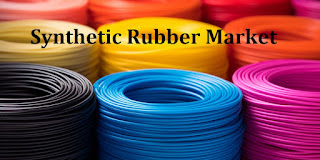Synthetic Rubber Market Expected to Hit $42.3 Billion by 2031, According to Meticulous Market Research Pvt. Ltd.
Meticulous Research®, a leading global market
research firm, has released its latest report titled, 'Synthetic Rubber
Market Size, Share, Forecast, & Trends Analysis by Type (SBR, EPDM, BR,
SBC, IIR, NBR, IR, CR), Application (Tires, Textiles & Apparel,
Electronics, Packaging), Industry (Construction, Automotive, Industrial) -
Global Forecast to 2031.'
Download Sample Report Here @ https://www.meticulousresearch.com/download-sample-report/cp_id=5848
The report by Meticulous Research® forecasts that the
synthetic rubber market will achieve $42.3 billion by 2031, expanding at
a CAGR of 4.4% from 2024 to 2031. The growth is driven by increased
construction and infrastructure development activities, higher vehicle
production, and expansion in industrial sectors like manufacturing. The demand
for eco-friendly synthetic rubber alternatives is also expected to contribute
to market growth. However, challenges such as waste management issues,
environmental pollution, and stringent regulations may affect market progress.
The synthetic rubber market is segmented by type,
application, and end-use industry, with detailed analysis of competitors and
regional markets.
Segmentation by Type:
The market is divided into various types including styrene
butadiene rubber (SBR), polybutadiene rubber (BR), styrene block copolymer
(SBC), ethylene propylene diene rubber (EPDM), butyl rubber (IIR),
acrylonitrile-butadiene rubber (NBR), isoprene rubber (IR), chloroprene rubber
(CR), and others. In 2024, styrene butadiene rubber (SBR) is expected to
hold the largest market share of over 29.0%, driven by its extensive use
in tire manufacturing due to its excellent durability and wear resistance. The
increasing adoption of green tire technologies, which incorporate higher
proportions of bio-based and recycled materials like SBR, further drives this
segment’s growth.
Conversely, the ethylene propylene diene rubber (EPDM)
segment is projected to grow at the fastest rate between 2024 and 2031. This
growth is driven by the increased use of EPDM in construction, automotive
applications, and renewable energy technologies due to its superior weather
resistance and durability.
Segmentation by Application:
The synthetic rubber market is segmented by application into
tires, automotive (non-tire), footwear components, textiles & apparel,
seals & gaskets, hoses & belts, electronic devices, lubrications,
packaging, and others. The tires segment is expected to dominate with a
share of over 72.0% in 2024, driven by the expanding automotive industry
and the rising demand for tire replacements due to wear and tear.
On the other hand, the electronic devices segment is
anticipated to experience the highest growth rate during the forecast period.
The growth is supported by the expanding consumer electronics market,
increasing popularity of wearable devices, and the growth of telecommunication
infrastructure, including 5G networks. The growing use of synthetic rubber in
electronic components further supports this trend.
Segmentation by End-use Industry:
The market is segmented by end-use industry into
construction, automotive, industrial manufacturing, footwear, aerospace,
consumer electronics, and others. The automotive segment is expected to
hold the largest market share of over 76.0% in 2024. This dominance is
attributed to the growth of the automotive industry and the extensive use of
synthetic rubber in automotive parts.
The consumer electronics segment is forecasted to
grow at the fastest rate from 2024 to 2031, driven by technological
advancements, increasing demand for wearable devices, and the expansion of IoT
devices.
Regional Analysis:
The synthetic rubber market is geographically segmented into
North America, Europe, Asia-Pacific, Latin America, and the Middle East &
Africa. Asia-Pacific is anticipated to lead with a market share of over 54.0%
in 2024 and a CAGR of over 6.0%. The region’s growth is driven by rising
demand across industries, rapid urbanization, infrastructure development, and
supportive government policies in countries such as China, Japan, South Korea,
and India.
Key Players:
The key players operating in the synthetic rubber market are
China Petrochemical Corporation (a subsidiary of Sinopec Corp.) (China), ERIKS
N.V.(Netherlands), The Dow Chemical Company (U.S), Exxon Mobil Corporation
(U.S.), Kumho Petrochemical Co., Ltd. (KKPC) (South Korea), Zeon Corporation
(Japan), Nizhnekamskneftekhim (Russian), Mitsui Chemicals, Inc. (Japan), JSR
Corporation (Japan), SABIC (Saudi Arabia), Denka Company Limited (Japan), Asahi
Kasei Corporation (Japan), Indian Synthetic Rubber Private Limited (India),
Apcotex (India), Reliance Industries Limited (India), Trinseo PLC (U.S.), TSRC
Corporation (Taiwan), Michelin Group (France), and LANXESS (Germany).
To gain more insights into the market with a
detailed table of content and figures, click here: https://www.meticulousresearch.com/product/synthetic-rubber-market-5848
Key questions answered in the report:
- Which
are the high-growth market segments based on type, application, end-use
industry, and geography?
- What
was the historical market for the synthetic rubber market?
- What
are the market forecasts and estimates for the period 2024–2031?
- What
are the major drivers, restraints, opportunities, and challenges in the
synthetic rubber market?
- Who
are the major players, and what shares do they hold in the synthetic
rubber market?
- What
is the competitive landscape in the synthetic rubber market?
- What
are the recent developments in the synthetic rubber market?
- What
are the different strategies adopted by the major players in the synthetic
rubber market?
- What
are the key geographic trends, and which are the high-growth countries?
- Who
are the local emerging players in the global synthetic rubber market, and
how do they compete with the other players?
Contact Us:
Meticulous Research®
Email- sales@meticulousresearch.com
Contact Sales- +1-646-781-8004
Connect with us on LinkedIn- https://www.linkedin.com/company/meticulous-research

Comments
Post a Comment